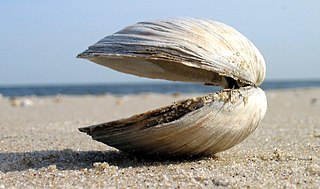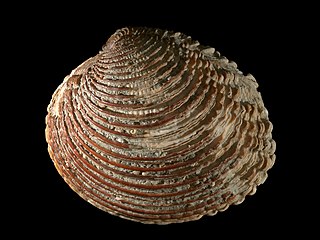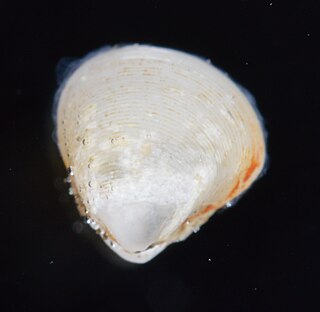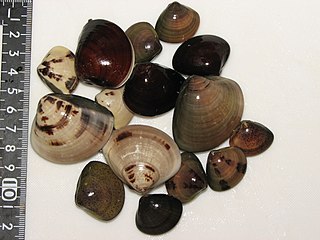
Clam is a common name for several kinds of bivalve molluscs. The word is often applied only to those that are edible and live as infauna, spending most of their lives halfway buried in the sand of the seafloor or riverbeds. Clams have two shells of equal size connected by two adductor muscles and have a powerful burrowing foot. They live in both freshwater and marine environments; in salt water they prefer to burrow down into the mud and the turbidity of the water required varies with species and location; the greatest diversity of these is in North America.

The hard clam, also known as the round clam, hard-shellclam, or the quahog, is an edible marine bivalve mollusk that is native to the eastern shores of North America and Central America from Prince Edward Island to the Yucatán Peninsula. It is one of many unrelated edible bivalves that in the United States are frequently referred to simply as clams. Older literature sources may use the systematic name Venus mercenaria; this species is in the family Veneridae, the venus clams.

The Veneridae or venerids, common name: Venus clams, are a very large family of minute to large, saltwater clams, marine bivalve molluscs. Over 500 living species of venerid bivalves are known, most of which are edible, and many of which are exploited as food sources.

Mercenaria is a genus of edible saltwater clams, marine bivalve molluscs in the family Veneridae, the Venus clams.

Venus is a genus of small to large saltwater clams in the family Veneridae, which is sometimes known as the Venus clams and their relatives. These are marine bivalve molluscs.

The amethyst gem clam is species of very small saltwater clam, a marine bivalve mollusk in the family Veneridae, the Venus clams.

Lajonkairia lajonkairii is an edible species of saltwater clam in the family Veneridae, the Venus clams.

Leukoma is a genus of saltwater clams, marine bivalve molluscs in the family Veneridae, the Venus clams. This genus of bivalves has been exploited by humans since prehistory; for example, the Chumash peoples of California harvested this genus from Morro Bay in approximately 1000 AD.
Saxidomus, common name the "Washington clams", is a genus of large edible saltwater clams, marine bivalve mollusks in the family Veneridae, the Venus clams.

Saxidomus nuttalli is a species of large edible saltwater clam, a marine bivalve mollusk in the family Veneridae, the venus clams. Common names include California butterclam and Washington clam.

Ruditapes largillierti is a saltwater clam, a marine bivalve mollusc in the family Veneridae, the Venus clams. They are moderately large for their genus, elongate and subrectangular, thick and solid, with smooth ventral margin.

Tivela stultorum, also known as the Pismo clam, is a species of large, edible, saltwater clam, a marine bivalve mollusk in the family Veneridae, the Venus clams. This species is native to the eastern Pacific Ocean. As the name implies, the Pismo clam lives in Pismo Beach, California. It has been found at least as far south as 300 miles south of the US–Mexico border in Baja California on the Pacific Ocean side, where strong surf sometimes washes ashore live clams. The indigenous peoples of California used this species for food.

Periglypta is a genus of bivalves in the subfamily Venerinae of the family Veneridae.
Lamelliconcha circinata, common name the "purple venus clam", is a species of bivalve mollusc in the family Veneridae, the venus clams. This species can be found around the coasts of the islands in the West Indies.

Macrocallista is a genus of saltwater clams, marine bivalve mollusks in the family Veneridae, the Venus clams.

Meretrix lusoria, the hamaguri, Asian hard clam or common Orient clam, is a species of saltwater clam, a marine bivalve mollusk in the family Veneridae, the Venus clams. This species is native to Asia, found along water beds and the coastal waters of China, Korea, Sarawak, and Japan. It is commercially exploited for sushi, and its shells are traditionally used to make white go stones.

Meretrix is a genus of edible saltwater clams, marine bivalve molluscs in the family Veneridae, the Venus clams. They appeared in the fossil record in the Cenomanian age.

Paratapes undulatus, common name undulate venus, is a species of saltwater clam, a marine bivalve mollusk in the family Veneridae, the Venus clams.

Cyclina sinensis, commonly known as Chinese venus, black clam, iron clam, and Korean cyclina clam, is a clam species in the venus clam family, Veneridae. It mostly lives in the flats on the coast of seas in East Asia, such as the Yellow Sea and the West sea.
















